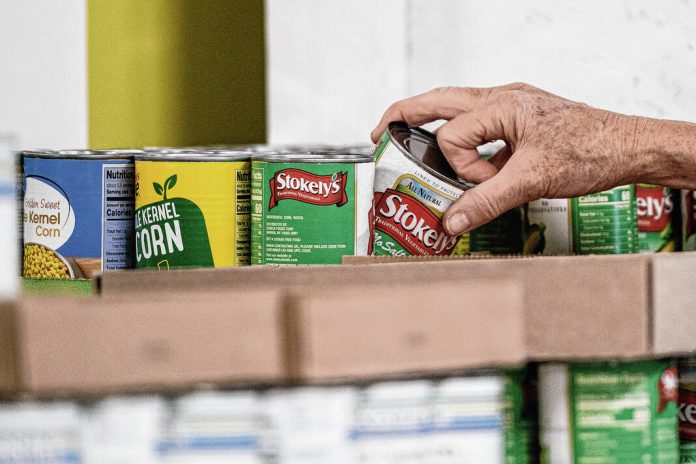
Mike Wolanin | The Republic Linda Mark picks up a can of corn from a shelf at the Love Chapel food pantry on Monday, Nov. 20, 2023, in Columbus, Indiana.
Local food pantries and researchers say the number of food-insecure children in Bartholomew County and surrounding areas has risen in recent years, largely due to inflation, the end of pandemic-era assistance and what some local officials say may reflect widening disparities.
Love Chapel, 292 Center St., has seen demand for its weekly care packages with food for Bartholomew County elementary school students double since 2021, said Executive Director Kelly Dougherty.
The care packages are delivered weekly to elementary school students after teachers assess “students deemed to be at nutritional risk over the weekend,” and typically contain ready-to-eat foods like crackers, fruit cups, pudding cups and power bars that staff rotate to provide variety. Kids also receive a jar of peanut butter each month.
Dougherty said Love Chapel was preparing an average of 400 school care packages per week in 2021. During the final week of school this year, Love Chapel prepared 810 school care packages.
“(Child food insecurity) is real,” Dougherty said, “and I think a lot of people in our community don’t believe it’s real, but it is.”
“The school care packages that we’re doing are probably a pretty good measure of what we’ve been looking at,” Daughtery added.
At the same time, about 47 percent of Bartholomew Unified School District students, or 5,452 students, received free or reduced-price lunches in the most recent school year, up from 34 percent of students in the school year prior to 2006, according to Indiana State Department of Education records.
Half of the students in the Flat Rock-Haw Creek School District (467 students) received free or reduced-price lunches last school year, up from 34 percent in the 2005-2006 school year.
Additionally, 66 percent of Jennings County School Board students received free or reduced-price lunches last school year, as did about 52 percent of Seymour Community Schools students.
The Indiana Department of Education’s figures are based on data reported to the state by Indiana schools, said spokeswoman Molly Williams. Statewide, about 48% of students in schools that reported data to the Indiana Department of Education received free or reduced-price lunches last school year.
Eligibility for free or reduced-price lunches depends on income and household size: Children who live in households earning less than 185% of the Federal Poverty Guidelines typically qualify for reduced-price meals, and children who live in households earning less than 130% of the Federal Poverty Guidelines typically qualify for free meals.
For a family of four, the annual income limit for reduced-price lunches is $57,720 for the next school year, and $40,560 for free school meals, according to the Indiana Department of Education and the U.S. Department of Agriculture’s Food and Nutrition Service.
“In addition to providing meals during the school term, our food service department does a great job providing meals to support communities and families over the summer,” said Josh Barnett, BCSC communications coordinator.
The latest updates from local officials come as recently released data from Feeding America, the nation’s largest anti-hunger organization, suggests food insecurity has skyrocketed in Bartholomew County and surrounding areas in 2022, with 1,790 new local children becoming food insecure.
In Bartholomew County, child food insecurity rates rose from 10.3% in 2021 to 15% in 2022, the highest rate since 2018. A total of 2,950 children in the county experienced food insecurity in 2022, up from 2,030 in 2021, according to data from Feeding America’s “Map the Meal Gap 2024” report, released last month.
Similar increases were reported in neighboring counties.
In Jackson County, the child food insecurity rate will rise from 11.4% in 2021 to 16% in 2022, with 400 new children experiencing food insecurity, according to Feeding America. In Jennings County, the rate rose from 13.1% in 2021 to 19.5% in 2022.
Overall, a total of 5,960 children are estimated to experience food insecurity in the three counties in 2022, up from 4,170 the year before.
In Indiana, the child food insecurity rate increased from 12.9% in 2021 to 18.2% in 2022, according to Feeding America. The U.S. Department of Agriculture reports that 18.5% of children nationwide may be experiencing food insecurity.
“As pandemic relief programs ended and household costs (including food) rose, so did levels of food insecurity,” Feeding America’s Map the Meal Gap 2024 report states. “…Food insecurity is a symptom of historical and structural oppression, not individual vulnerability. Food insecurity does not exist in a vacuum. People who have difficulty obtaining enough food also have difficulty obtaining adequate housing, health care, transportation, and other basic needs.”
According to the United States Department of Agriculture, food insecurity is when a person does not have enough food to lead an active, healthy life. Experts say a lack of access to nutritious food can affect children’s development, behavior and psychology.
“During the first few years of life, a balanced diet is crucial to a child’s development,” says New Jersey-based nonprofit Move for Hunger. “Children who don’t have access to enough nutritious food during this time are more likely to grow slowly and have trouble learning. Later in life, these children also tend to get sick more easily and be hospitalized more often than children from food-secure homes.”
Dougherty said he wasn’t surprised that Feeding America’s data showed an increase in food insecurity among local children, and that it “confirms what we’ve seen” at Love Chapel.
“I think Columbus is probably further along than most other communities. I’m not criticizing Columbus,” Daughtery said, “certainly there are a lot of good-paying jobs, a lot of nice places to live, a lot of people who are generous with the money they’ve earned from years of service. It’s a good town. But there’s another side to the town that people don’t really realize, and that side is growing. There are more people who fit that category.”


